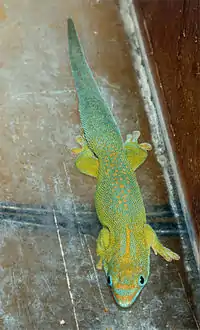Yellow-throated day gecko
The yellow-throated day gecko (Phelsuma flavigularis) is an endangered diurnal species of gecko from eastern Madagascar. It typically inhabits rainforests and dwells on trees. This endangered species feeds on insects and nectar.
| Yellow-throated day gecko | |
|---|---|
 | |
| Scientific classification | |
| Domain: | Eukaryota |
| Kingdom: | Animalia |
| Phylum: | Chordata |
| Class: | Reptilia |
| Order: | Squamata |
| Family: | Gekkonidae |
| Genus: | Phelsuma |
| Species: | P. flavigularis |
| Binomial name | |
| Phelsuma flavigularis Mertens, 1962 | |
 | |
Description
This lizard belongs to the medium-sized day geckos. Males can reach a total length of about 15 cm (5.9 in) while females are often much smaller. The body colour is dark green or bluish green. On the snout there are two red transversal bars. One to three rust-coloured stripes may be present on the neck. On the back there are small brownish or reddish dots and spottings. The throat is light yellow and the ventral side is beige. P. flavigularis has blue eye rings.
Distribution
This species has a limited distribution. It is only known from the area around Andasibe on the east coast of Madagascar, about 100 km (62 mi) east of Antananarivo.
Habitat
P. flavigularis is found on banana trees and palms. Its original habitat are rainforests. The east coast of Madagascar has a humid and warm climate.

Diet
These day geckos feed on various insects and other invertebrates. They also like to lick soft, sweet fruit; pollen; and nectar.
Behaviour
Like most Phelsuma spec., this species can be quite quarrelsome and do not accept other males in their neighbourhood. In captivity, where the females cannot escape, the males can also sometimes seriously wound a female during courtship. In this case, the male and female must be separated immediately.
Care and maintenance in captivity
These animals should be housed in pairs and need a large, well planted terrarium. The temperature should be between 25 and 28 °C. The humidity should be maintained between 75 and 100%. In captivity, these animals can be fed with crickets, wax moths, fruit flies, mealworms, and houseflies.
References
- Raxworthy, C.J. & Vences, M. (2011). "Phelsuma flavigularis". The IUCN Red List of Threatened Species. IUCN. 2011: e.T178689A7596336. doi:10.2305/IUCN.UK.2011-2.RLTS.T178689A7596336.en. Retrieved 15 January 2018.
- Henkel, F.-W. and W. Schmidt (1995) Amphibien und Reptilien Madagaskars, der Maskarenen, Seychellen und Komoren. Ulmer Stuttgart. ISBN 3-8001-7323-9
- McKeown, Sean (1993) The general care and maintenance of day geckos. Advanced Vivarium Systems, Lakeside CA.
